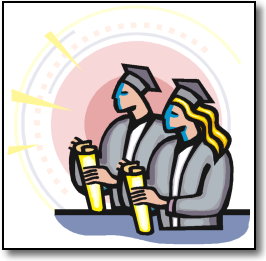 | ||||||
|
| ||||||
|
* * * * CLICK HERE * |
THIS MONTH'S ESSAY Is America in Jeopardy? Many people start the summer with a summer reading list - things to catch up on while enjoying a day at the beach, an afternoon in the park, or a balmy evening sipping coffee at a local cafe. This year's essay series will conclude with a fall/winter/spring "reading list" and a few related comments relating to both science/technology and something on many people's minds these days: jobs and America's prosperity. In hurricane forecasting terminology, a category five storm is the strongest possible one, a devastating one certain to cause significant destruction. This past year a report was published which concluded that: "Today, for the first time in history, America's younger generation is less well-educated than its parents. For the first time in the
nation's history, the health of the younger generation has the potential to be inferior to that of its parents. And only a minority of American adults believes that the standard of living of their children will be higher than what they themselves have
enjoyed. To reverse this foreboding outlook will require a sustained commitment by both individual citizens and by the nation's government . . . at all levels. The Gathering Storm is looking ominously like a Category 5 . . . and, as the nation has so
vividly observed, rebuilding from such an event is far more difficult than preparing in advance to withstand it." Rising Above the Gathering Storm, Revisited: Rapidly Approaching Category 5, pp. 55 - 56 (n1) The report, entitled "Rising Above the Gathering Storm, Revisited: Rapidly Approaching Category 5," was the 2010 follow-up to the original 2005 report "Rising Above the Gathering Storm: Energizing and Employing America for a Brighter Economic Future," as well as a corrolary essay (by Norman Augustine, the chairman of the original report committee) entitled "Is America Falling off the Flat Earth?" The three publications make up the "reading list," and links to full PDFs of all three will be included at the end of the essay.
What Was "The Gathering Storm", and What Are The National Academies? "The thrust of the Academies' findings is straightforward. First, the report concludes that individual prosperity depends predominantly on individuals having high-quality jobs. It also
observes that the same is true of a nation's collective prosperity, in that if there are few high-quality jobs, there are not likely to be sufficient tax revenues to ensure homeland security, provide health care, pay Social Security, or educate the nation's children. Second, the report concludes that the creation of new, high-quality
jobs is today disproportionately dependent on advances in science and engineering." Is America Falling off the Flat Earth?, p. 15 (n2) "During the years since the Gathering Storm report was produced there has been another change in the character of job creation in America that presumably cannot sustain itself over
the longer term. In particular, during this period the private sector eliminated 4,755,000 jobs while government (at all levels) added 676,000 jobs. The difficulty of reversing this trend is exacerbated by yet another development wherein, according to the Bureau of Labor Statistics,
federal jobs now pay wages and benefits that on average exceed those in the private sector by 55 percent for similar occupations." Rising Above the Gathering Storm, Revisited: Rapidly Approaching Category 5, p. 37 (n3) In 2005, letters from members of both parties in the U.S. Senate and House of Representatives were sent to the National Academies requesting a formal study on America's competitiveness. The study, conducted by the National Academies with their own funds (n4), was completed the same year. In order to conduct the study, the Academies' Committee on Science, Engineering and Public Policy established the Committee on Prospering in the Global Economy of the 21st Century. Committee members included scientists, school superintendents, university presidents, current and former CEOs of Fortune 100 corporations, and Nobel Prize laureates, among others. Their task was to investigate the following two questions: • What are the top 10 actions, in priority order, that federal policymakers could take to enhance the science and technology enterprise so that the United States can successfully compete, prosper, and be secure in the global community of the 21st century? • What implementation strategy, with several concrete steps, could be used to implement each of those actions? (n5) The report described key elements of American prosperity in the 21st century, provided an overview of how science and technology are critical to that prosperity, evaluated how the U.S. was doing in science and technology at the time, and offered scenarios of possible outcomes of both U.S. success and failure in maintaining a technological lead vis-a-vis the rest of the world. Topics covered in the report included the idea of jobs and human capital in a global economy, innovation, standards of living and educational challenges. In the end the committee came up with twenty specific recommendations for action in four key areas: K-12 science and mathematics education, science and engineering research, science and engineering higher education, and economic and technology policy. Who or what are the National Academies, and why would they be the ones to conduct such as study? The National Academies are "advisors to the nation on science, engineering and medicine." Under the National Academies umbrella can be found the National Academy of Sciences, the National Academy of Engineering, the Institute of Medicine and the National Research Council. The units work both separately and together to examine policy, conduct research on furthering science and technology and their use for the public's general welfare, and advise the federal government. The 2005 "Gathering Storm" study was conducted under the auspices of the National Academy of Sciences, National Academy of Engineering and Institute of Medicine. The report committee was chaired by Norman Augustine, an engineer, retired CEO and Chairman of the Lockheed Martin Corporation; former Chairman of the National Academy of Engineering, Aerospace Industries Association, and Defense Sciences Board; a current or former member of the boards of directors of ConocoPhillips, Black & Decker and Procter & Gamble; fifteen-year member of the President's Council of Advisors on Science and Technology; and a recipient of the National Medal of Technology, the Joint Chiefs of Staff Distinguished Public Service Award, and the Department of Defense's highest civilian decoration, the Distinguished Service Medal. His 2007 essay "Is America Falling Off the Flat Earth?" looked at the "Gathering Storm" issues about one and a half years after the original study was completed.
Five Years Later: A "Storm" Revisited In the period immediately following the publication of the first "Gathering Storm" report, many media stories appeared, "Gathering Storm" topics were discussed throughout the nation, and Congress passed legislation known as the America COMPETES Act to implement many of the report's recommendations. The purpose of the 2010 "Gathering Storm Revisted" update was to assess the progress which had been made since the first report was completed. The "Revisited" report includes indications of what actions were taken on the committee's original recommendations, but its conclusions are not rosy. The committee asks "Where does America stand relative to its position of five years ago when the Gathering Storm report was prepared? It answers the question by saying: "The unanimous view of the committee members participating in the preparation of this report is that our nation's outlook has worsened. While progress has been made in certain areas -- for example, launching the Advanced Research Projects Agency - Energy -- the latitude to fix the problems being confronted has been severely diminished by the growth of the national debt over this period from $8 trillion to $13 trillion. Further, in spite of sometimes heroic efforts and occasional very bright spots, our overall public school system - or more accurately 14,000 systems - has shown little sign of improvement, particularly in mathematics and science. Finally, many other nations have been markedly progressing, thereby affecting America's relative ability to compete effectively for new factories, research laboratories, administrative centers - and jobs. While this progress by other nations is to be both encouraged and welcomed, so too is the notion that Americans wish to continue to be among those peoples who do prosper. The only promising avenue for achieving the latter outcome, in the view of the Gathering Storm committee and many others, is through innovation. Fortunately, this nation has in the past demonstrated considerable prowess in this regard. Unfortunately, it has increasingly placed shackles on that prowess such that, if not relieved, the nation's ability to provide financially and personally rewarding jobs for its own citizens can be expected to decline at an accelerating pace. The recommendations made five years ago, the highest priority of which was strengthening the public school system and investing in basic scientific research, appears to be as appropriate today as then. The Gathering Storm Committee's overall conclusion is that in spite of the efforts of both those in government and the private sector, the outlook for America to compete for quality jobs has further deteriorated over the past five years. The Gathering Storm increasingly appears to be a Category 5." (n7) One factor in the education equation today for those who would presumably be the workforce of tomorrow is student loans. Though touched on only briefly in the report, the situation with student loans has the potential of becoming a Category 5 storm in its own right. The report mentions a figure of $633 billion as total outstanding student loan debt. (n8) This figure, however, is based on information from 2009. The actual amount is much higher. In August of 2010 it was noted in a number of articles that for the first time student loan debt for consumers in the U.S. had exceeded consumer credit card debt. One Wall Street Journal article, for example, cited figures estimating total student loan debt at about $830 billion, as compared outstanding revolving credit debt (the majority of which is credit card debt) at about $827 billion. It also notes in the article that almost $300 billion in student loan debt has been incurred in the last four years alone. (n9). Reporters, bloggers and experts have been writing about and warning about the dangers of increasing student loan debt for years, but little if anything, appears to have changed within the system. What's This Worth? Computers, unlike fine wine, generally do not improve with age (future models may improve, but not individual units such as the one pictured below). Note, however, the finer points of this early IBM portable computer: the generously-proportioned screen, sleek dual matching floppy drives (who needs an internal hard drive, anyway?), convenient pull-out handle for carrying, nearly full-sized keyboard, with, of course, the must have accessory - a portable Diconix printer (matching paper with holes along the perforated edges for proper alignment not shown). Although it may be hard to believe, this "wow" of a late 1980s piece of technology was a mandatory purchase for the Harvard Business School incoming class in the fall of 1987.
Unlike most computers, however (and despite the fact that in could be seen on home shopping TV channels for about a third of the original price or less even before grad school ended), the price of this computer goes up with each passing year. What, you might ask - are museums actively competing to gain hold of this miracle of modern technology, eager to scoop up one of the last few which may exist? Not exactly. This babe of a computer will celebrate its 25th birthday next year with an increasing price because it was financed with student loans. Whereas any rational individual might choose an option to cut his or his losses and allow scarce capital to be allocated to a more productive use (like purchasing a new computer), the student loan system won't allow this, except under the most extreme circumstances. So perhaps this computer's best - and only - use (other than, perhaps, a door stop) is as a metaphor for what is happening to more and more students today: being forced to pay increasing amounts on debt for something which in some cases has long outlived its usefulness and value. To be fair, a majority of students still pay off their loan debts according to schedule, but there are also those who are not able to. And figures in recent years suggest that the number of students defaulting on their loans is rising. The toll this takes is personal as well as financial - both to the individuals holding the loans as well as to the country, especially in terms of loss of human and productive capital. Surely, the reader may say, there must be some way of resolving student loan debt. There are several options, most of which were discussed in the very first essay ever included on the site in August 2003 (part of the reason the site even exists at all, and available in the Essay Archives section). One option not included in that essay but which will be discussed here is the Public Service Loan Forgiveness Program as outlined in 34 CFR Ch. VI, section 685.219. (n10) Before reading further, think of the dollar volume of outstanding student debt. Think also of the increasing number of students taking out loans and perhaps seeking some measure of relief in the future. Then think of both the earlier statment about the unsustainability of increasing government employment in the long term at the expense of private sector employment and the size of the federal deficit. Then read the provisions of the law. The stated purpose of the program (in part "a") is "to encourage individuals to enter and continue in full-time public service employment by forgiving the remaining balance of their Direct loans after they satisfy the public service and loan payment requirements of this section." What are those requirements? Ten years of full-time public service employment, and 120 separate monthly payments toward the loan (after which if it is not paid off, the balance will be forgiven). Notwithstanding the value of the program for steering individuals into areas where there may be a distinct need such as in teaching or the military, is there really such a shortage of government employees to make this a truly valuable program for the taxpayer (who presumably will be footing the bill for ten years of salary, benefits, accrued pension obligations, etc.) if evaluated strictly on a financial basis? The law states that the individual must be a full-time employee working an average of 30 hours a week in a paid position in a public service organization. Public service organizations for the purposes of the law are defined as: a federal, state, local, or Tribal government organization, agency, or entity; a public child or family services agency; a non-profit organization under section 501(c)(3) of the Internal Revenue Code that is exempt from taxation . . .; a Tribal college of university; an organization that provides (any) of the following public services: emergency management, military service, public safety, law enforcement, public interest law services, early childhood education (including licensed or regulated child care, Head Start, and State-funded pre-kindergarten); public services for individuals with disabilities and the elderly; health services (including nurses, nurse practitioners, nurses in a clinical setting, and full-time professionals engaged in health care practitioner occupations, as such terms are defined by the Bureau of Labor Statistics); public education; public library services; school library or other school-based services." There are only four types of employment specifically excluded by the law: business organized for profit, labor unions, partisan political organizations and organizations engaged in religious activities, unless the qualifying activities are unrelated to religious instruction, worship services or any form of proselytizing. Consider this in terms of a hypothetical loan repayment situation (numbers for the purpose of this example are drawn from figures in a Loan Repayment pdf found at www.finaid.org, a site monitoring student financial aid issues) (n11). Say, for example, the initial loan taken out was $25,000 at 6.8% interest on a standard 10-year term. With a normal 10-year payment program, payments would be about $288 per month with interest over the life of the loan at $9,524, for a total repayment amount of $34,524. If a student needed to extend the term of the loan to 20 years in order to lower payments to $191 per month, the interest over the life of the loan would be $20,802 with a total repayment after 20 years of $45,802. If the student decided to enter the Public Service Loan Forgiveness Program after making five years of payments, then continued payments at the same rate for the next ten years, the amount paid after 15 years (15 years x 12 payments/year x $191 per payment) would be $34,380. The $11,460 remaining on the loan which would have been paid over the final five years of payments would be forgiven by the government after the ten years of employment. Over the fifteen years of payment, the government/lending agency would have received about $15,600 in interest. If the person earned a salary of $25,000 in each of the ten years of government employment with benefits (health care, etc.) valued at about $5,000 a year, then the government expenditure on that one employee would be roughly $300,000 over ten years. Deducting the $15,600 in interest gained from the expenditure of $300,000 cost of the employee would leave a net government expense of $284,400 for hiring the employee as opposed to a ballpark loss of less than the $25,000 original loan amount if the loan was dismissed through bankruptcy proceedings. In the case of a taxpayer-funded government position, the actual value to the government could depend on how necessary the employee would be as compared to the extra burden placed on the taxpayer in absorbing the cost of another government employee. In the current economic climate where jobs are scarce and a high unemployment rate lingers, the question might also be asked as to why an anti-business/anti-profit bias is codified into law through the student loan repayment system. There are those who believe that creating good jobs and generating taxable revenue (which could lead to reducing government deficits) could be considered as much a public service as any of the "service" functions listed above. Why not institute some type of student loan credit/forgiveness which could be based on objective criteria such as taxable revenue generated from a new enterprise or number of new employees hired? Granted it is unlikely the great numbers of debt-relief-seeking former students would have large amount of capital available to launch new enterprises, but why not open the door to the opportunity should it arise? A Personal Note on Women and Science
While waiting to get a few other personal aspects straightened out, I decided to enroll in an electronics course at a local community college just to test the waters. I was told by the instructor at the end of the course that I had received the highest grade in the class on the final examination. While it would have been nice to have received encouragement to continue at more advanced levels, instead I found a copy of "The Rules" (of dating) enclosed in the mail with my final course scores. I ignored the paper and continued with courses on one of the U.C. campuses which I began with the intention of completing a second baccalaureate degree in a science-related field. I completed four courses (two basic biology courses, introductory genetics and introductory neuroscience), and though my grades were in the top 10% of each of the classes I took, I received absolutely no encouragement to continue. After the fourth class it was clear to me that there weren't going to be funds to continue in the direction I'd hope to take. I bought the book and completed the coursework on my own for the first introductory chemistry course, but then had to stop the coursework entirely. Looking for some type of marker to "mark" the direction I might have taken if I had been able to continue, I decided to take the Graduate Records Exam (GRE) in Biochemistry, Cellular and Molecular Biology. I had about two months to study for the test and "raided" every university library in the area gathering materials that might in some way help me to study for the exam. In two months I managed to piece together information which would have been covered in the undergraduate coursework which would have prepared me for the exam, then sat for the test. I managed to pass, albeit at the equivalent of a low "C" level, but was pretty satisfied with the results. Since that time I've had to abandon all except what remains in this essay series for the site. What surprised me most over the last decade, however, was the hostility I encountered in pursuing this course of action -- not so much from those within the science/technology world but from those outside of it. It would be impossible to encapsulate here the comments received over more than a decade, but most revolved around suggestions that this was "man's work" and that if I was interested in it I must have some inner desire to be a man (which I can most definitely assure you is not the case). There is not a single word of encouragement that I have encountered over a more than 15-year period in pursuing any aspect of learning or work in a science-related environment. So, . . . that's my experience, but given the context of the Gathering Storm reports, I certainly hope it's not the same experience that others have had. Perhaps women will never make up high percentage of those pursuing science- or technology-related degrees or work. If others have had anything close to the experiences which I have had, however, it will probably come as no surprise that they don't. Is America in Jeopardy? Pardon the play on words, but the first essay of the season included information about IBM's Watson computer competing as a contestant on the television game show "Jeopardy!" Watson won the Jeopardy! tournament with ease, defeating both its human competitors. If Watson, as an innovation and technological achievement was to represent either the U.S. or the rest of the world, and if Watson's human contestants as runners up to Watson's prowess were to represent either the U.S. or the rest of the world which would be which? If the predictions of the Gathering Storm reports are correct, the U.S. as Watson may not be something we can expect in the very near future. What happens remains to be seen.
FOOTNOTES - The following are the footnotes indicated in the text in parentheses with the letter "n" and a number. If you click the asterisk at the end of the footnote, it will take you back to the paragraph where you left off. n1 - Members of the 2005 "Rising Above the Gathering Storm" Committee, National Academy of Sciences, National Academy of Engineering and National Institute of Medicine, Rising Above the Gathering Storm, Revisited: Rapidly Approaching Category 5, Washington, D.C.: National Academies Press, 2010, p. 55 - 56 (*) n2 - Augustine, Norman R., Is America Falling off the Flat Earth?, Washington, D.C.: National Academies Press, 2007, p. 15 (*) n3 - Rising Above the Gathering Storm, Revisited, p. 37 (*) n4 - Committee on Prospering in the Global Economy of the 21st Century, National Academy of Sciences, National Academy of Engineering and National Institute of Medicine, Rising Above the Gathering Storm: Energizing and Employing America for a Brighter Economic Future, Washington D.C.: National Academies Press, 2007, p. xi (*) n6 - Augustine, Is America Falling off the Flat Earth?, p. 1 and pp. 48 - 49 (*) n7 - Rising Above the Gathering Storm, Revisited, pp. 4 - 5 (*) n9 - Pilon, Mary, "Student Loan Debt Surpasses Credit Cards," Wall Street Journal Online, blogs, viewed September 2011 at http://blogs.wsj.com/economics/2010/08/09/student-loan-debt-surpasses-credit-cards (*) n10 - United States Code of Federal Regulations (CFR), 34 CFR Ch. VI, Section 685.219 (*) n11 - FastWeb, "Repaying Student Loans Quick Reference Guide," 2010, viewed online September 2011 at www.finaid.org/loans/RepayingStudentLoans.pdf (*) LINKS INCLUDED IN ESSAY - The following are links included in the essay.
BIBLIOGRAPHY - The following is the Bibliography for the September 2011 essay. Augustine, Norman R. Is America Falling off the Flat Earth?, Washington, D.C.: National Academies Press, 2007 Committee on Prospering in the Global Economy of the 21st Century, National Academy of Sciences, National Academy of Engineering and National Institute of Medicine, Rising Above the Gathering Storm: Energizing and Employing America for a Brighter Economic Future. Washington D.C.: National Academies Press, 2007 Council of Graduate Schools. "Data Sources: A Look at Loans and Cumulative Debt by Institutional Characteristics", viewed online September 2011 at www.cgsnet.org FastWeb, "Repaying Student Loans Quick Reference Guide," 2010, viewed online September 2011 at www.finaid.org/loans/RepayingStudentLoans.pdf FinAid "Student Loans," viewed online September 2011 at www.finaid.org/loans Members of the 2005 "Rising Above the Gathering Storm" Committee. National Academy of Sciences, National Academy of Engineering and National Institute of Medicine, Rising Above the Gathering Storm, Revisited: Rapidly Approaching Category 5, Washington, D.C.: National Academies Press, 2010 Pilon, Mary. "Student Loan Debt Surpasses Credit Cards," Wall Street Journal Online, blogs, viewed September 2011 at http://blogs.wsj.com/economics/2010/08/09/student-loan-debt-surpasses-credit-cards Stewart Debra W. Letter to Committee on Education and Labor, U.S. House of Representatives, RE: H.R.3221, The Student Aid and Fiscal Responsibility Act of 2009, July 16, 2009, viewed online September 2011 at www.csgnet.org United States Goverment. Code of Federal Regulations (CFR), 34 CFR Ch. VI, Section 685.219
Follow www.dorothyswebsite.org on TWITTER! Home | Essays |
Poetry | Free Concerts | Links | 2011 Extras |
About the Site |
|||||
 | ||||||
|
www.dorothyswebsite.org © 2003 - 2011 Dorothy A. Birsic. All rights reserved. Comments? Questions? Send an e-mail to: information@dorothyswebsite.org | ||||||






 Before concluding this essay and the summer series, one personal note will be added on the topics of "motivation" and "women in science/technology" as mentioned above. Although experiences undoubtedly vary
from person to person what is written here is simply the account of one person of forays into the worlds of science and technology. Most people familiar with graduate school programs know that there are usually a certain number of required courses, with the remainder being elective
courses presumably taken to further emphasize a particular area of interest or expertise. For me, these were courses in the final year of a three-year program which I designed combining two master's degrees. The courses were entrepreneurial management courses combined with a business school elective called "Managing and Developing
Technology," taught by one of the foremost experts in the field. All of my discretionary research revolved around some aspect of technology or technological change, and one part of a two-part thesis in the second master's program focused on the effects of technological change
on the nation state. Upon graduation I would have hoped to work for a science/technology-related enterprise, but that wasn't to be. Not surprisingly, few such firms would speak to me because of my lack of a technical background, and that is understandable. One firm, however, which spent a
generous amount of time speaking with me both during the graduate school recruitement process and at their headquarters office in Thousand Oaks was the biotechnology firm Amgen. The outcome of those conversations was advice which I took to heart - to gain management experience while at
the same time picking up the scientific coursework necessary to build up the technical side of my resume.
Before concluding this essay and the summer series, one personal note will be added on the topics of "motivation" and "women in science/technology" as mentioned above. Although experiences undoubtedly vary
from person to person what is written here is simply the account of one person of forays into the worlds of science and technology. Most people familiar with graduate school programs know that there are usually a certain number of required courses, with the remainder being elective
courses presumably taken to further emphasize a particular area of interest or expertise. For me, these were courses in the final year of a three-year program which I designed combining two master's degrees. The courses were entrepreneurial management courses combined with a business school elective called "Managing and Developing
Technology," taught by one of the foremost experts in the field. All of my discretionary research revolved around some aspect of technology or technological change, and one part of a two-part thesis in the second master's program focused on the effects of technological change
on the nation state. Upon graduation I would have hoped to work for a science/technology-related enterprise, but that wasn't to be. Not surprisingly, few such firms would speak to me because of my lack of a technical background, and that is understandable. One firm, however, which spent a
generous amount of time speaking with me both during the graduate school recruitement process and at their headquarters office in Thousand Oaks was the biotechnology firm Amgen. The outcome of those conversations was advice which I took to heart - to gain management experience while at
the same time picking up the scientific coursework necessary to build up the technical side of my resume. In Chess, as with many games with roots in more ancient times, the exact origin of the game is somewhat obscure. Historians
generally consider shatranj, developed in the Persian Empire around 600 A.D., to be one of the most direct ancestors of modern chess. Shatranj, however, grew to be a more refined version of
the earlier Indian games of chaturanga (a Sanskrit name for a battle formation) and ashtapada.
In Chess, as with many games with roots in more ancient times, the exact origin of the game is somewhat obscure. Historians
generally consider shatranj, developed in the Persian Empire around 600 A.D., to be one of the most direct ancestors of modern chess. Shatranj, however, grew to be a more refined version of
the earlier Indian games of chaturanga (a Sanskrit name for a battle formation) and ashtapada.